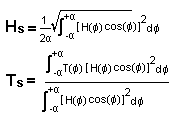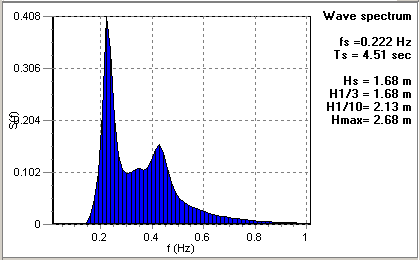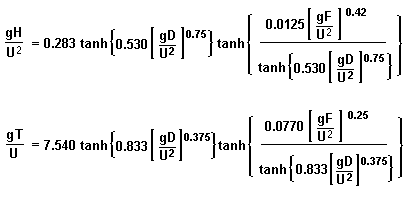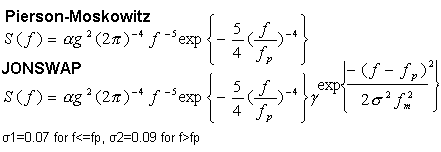| cgWindWaves, Methodology and
references |
|
Directional
spectrum effects
In narrow fetch areas there is a dominant
fetch for the wave prediction. In restricted fetch areas, there is not one dominant fetch
to predict the waves. In this case three methods have been implemented in the program. |
| Effective fetch method |
 The effective fetch method is obtaining an
equivalent fetch of the region by an weighted average process of the fetch of each sector,
from this fetch the significant wave height and period are predicted, and from them the
wave spectrum.
An effective fetch (Feff) obtained as a fetch weighted average, is
used for the prediction of significant wave height and significant wave period. F is the
fetch along a ray radiating from the point at which the waves is to be determined, and
making an angle a with the main wind direction. The integral is over a wind sector area
(usually from -p/2 to p/2) |
| Saville's Modified method 
Saville's method obtains an equivalent significant wave
height and period, by a weighted average process of the predicted significant wave height
and period for each sector. From the significant wave height and period the wave spectrum
is predicted
The significant wave height Hs obtained as weighted
average, and the significant wave period as the energy weighted average. H(a) and T(a) are
the wave height and wave period of waves generated along a ray radiating from the point at
which the waves are determined, and making an angle a with the main wind direction. The
integral is over a wind sector area (usually from -p/2 to p/2). |
| Seymour's method According to this the wave spectrum is computed for each sector and
the final predicted wave spectrum is obtained by adding up the energy of each sector's
spectrum.
The water region is separated in small sectors at angles a
around the main wind direction up to a boundary angle (usually from -p/2 to p/2). For each
sector the significant wave height and significant wave period are computed, and from them
a wave spectrum. The final wave spectrum is obtained from energy-average of all these
spectrums, and from this spectrum the significant wave height and significant wave period
are computed. |
| Significant
wave height and period
The mechanics wave generation by winds acting over
water surface is so complex factor that various semi-empirical methods have been
developed. The wave forecasting methods are based on semi-empirical relations (SMB methods
Sverdrup, Munk, and Bretschneider), which link the significant wave height Hs and
significant wave period to wind speed, fetch, and water depth.
In the program are implemented three basic and commonly used
methods. |
 |
| In this methods F is the fetch, U
the wind velocity, and g the acceleration of gravity, and D is the average depth f the
region. the nondimensional terms for significant wave height H and significant wave period
T are given as |
| Bretschneider's method 
[Seymour, R.J. "Estimating Wave Generation in
Restricted Fetches", J. ASME WW2, May 1977, pp251-263.] |
|
| Bretschneider's method with
depth effect 
[Seymour, R.J. "Estimating Wave Generation in
Restricted Fetches", J. ASME WW2, May 1977, pp251-263.] |
|
| Wilson's method 
[Bretschneider, Ch.I.."Topics in Ocean
Engineering, Volume 1", p31-32, Gulf Publishing Company, Houston Texas, 1969.] |
| Wave spectra Two commonly used wave spectral formulas are implemented in the
program

|
|
| References |
Bretschneider, C. I.."Topics in
Ocean Engineering, Volume 1", Gulf Publishing Company, Houston Texas, 1969.
Hallam M.G., Heaf N.J, Wootton, L.R., Dynamics of Marine
Structures, Ciria Underwater Engineering Group, London 1977.
Kinsman B., " Wind Waves." Prentice Hall, Inc.,
Englewood Cliffs, New Jersey 1965.
Muga B., J., and Wilson J. F. ," Dynamic Analysis of
Ocean Structures. " Plenum Press, New York, 1970
Newman, J., N. " Marine Hydrodynamics", MIT
Press, Cambridge, Massachusetts, 1977.
Seymour, R.J. "Estimating Wave Generation in
Restricted fetches", J. ASME WW2, May 1977, pp251-263.
World Meteorological Organization, "Handbook on Wave
Analysis and Forecasting", WMO No 446, Geneva Switzerland 1976
|
|
|

